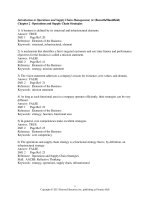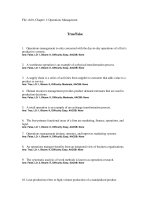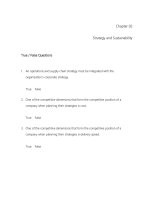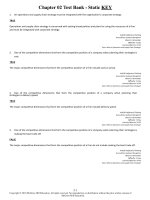Lecture Operations and supply chain management: The Core (3/e) – Chapter 4a: Learning curves
Bạn đang xem bản rút gọn của tài liệu. Xem và tải ngay bản đầy đủ của tài liệu tại đây (675.94 KB, 14 trang )
Learning Curves
Chapter 4a
McGrawHill/Irwin
Copyright © 2013 by The McGrawHill Companies, Inc. All rights reserved.
Learning Curves
A learning curve is a line that displays the
relationship between unit production and
cumulative number of units produced
One way of learning is “learning by doing”
As plants produce more, they gain experience in the
best production methods, which reduces their costs in
a predictable manner
This is observed as a decline in production costs (by a
specific percentage) each time cumulative production
doubles
Learning rates are unique and depend upon the nature of
the process
4a2
Learning Curves
Graphed on a
logarithmic scale, the
learning curve is a
straight line
4a3
Learning Curve Assumptions
4a4
Learning Curves
Learning curves can be developed from an
arithmetic tabulation, by logarithms, or some
other curve-fitting technique
The improved performance can be thought of
in two ways
Time per unit – shows the decrease in time
required for each successive unit
Output per time period – increase in number of
units produced over a fixed time period
4a5
Learning Curves
A 90% learning curve
implies that each
time cumulative
production doubles
the cost per unit is
reduced by 10%
Differences in learning
curves can have
dramatic effects over
time!
4a6
Learning Curves
A logarithmic plot allows linear extrapolation
and more accurate interpretation
Excel: Learning Curve Ca
4a7
Learning Curves – Logarithmic
Analysis
The relationship between total number of units
produced and learning can be expressed
mathematically
Excel: Learning Curves
4a8
Learning Curves – Logarithmic
Analysis
Example
For an 80% learning curve, if the first unit
required 100,000 hours, how many hours will the
eight unit require?
4a9
Learning Curve Tables
When the learning percentage is known,
tables can be used to estimate labor hours for
a specific unit
Multiply the initial unit labor hours by the
appropriate value from the table
Example: With an
80% learning rate, the
eighth unit should
take 0.512 times the
initial unit time. If Y 1 =
100,000, Y 8 =
100,000(0.512) =
51,200
4a10
Learning Curve Example
From table 4A.5, with an 80%
improvement ratio unit 11 should
take between 0.4765 and 0.4493
times the original time. Interpolate to
obtain a factor of 0.4629.
Overick has been slightly
overoptimistic
4a11
Learning Curve Example
Excel: Learning Cur
4a12
Managerial Considerations
4a13
Managerial Considerations
4a14









